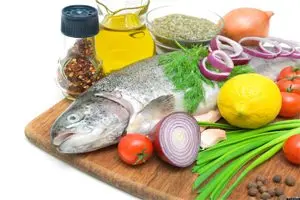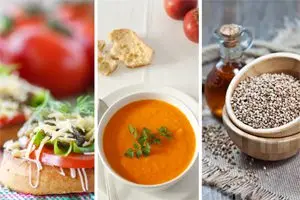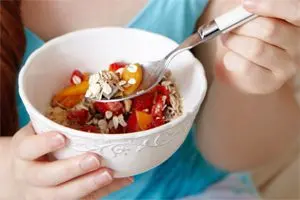Contents
Table 5 diet is a therapeutic nutrition scheme that is intended for people suffering from diseases of the liver, gallbladder, pancreas and other digestive organs. Thanks to diet No. 5, it is possible to normalize the work of the gastrointestinal tract, increase bile secretion and intestinal motility. In parallel, the load is removed from the liver, metabolism improves.
To make a menu for a week, you need to know the basic principles on which diet number 5 is based. It is important to understand that this nutrition system is not designed to save a person from extra pounds, it is necessary to maintain health and its main goal is to prevent exacerbation of existing diseases.

To properly compose your diet, you need to know what components should be included in the daily menu:
Products containing lipotropic substances (choline, lecithin, methionine). These substances are found in cottage cheese, eggs, kefir, milk, oatmeal and lean beef.
Foods containing a sufficient amount of fiber are, first of all, vegetables and sweet baked fruits, as well as cereals.
At least 2 liters of fluid must be consumed per day. We are talking about pure water without gas.
It is important to adhere to the following rules when compiling a menu for every day:
As first courses, you can cook a variety of vegetarian soups (vegetable, cereal, pasta, milk, fruit).
On the second course, dishes from lean meat (rabbit, beef, veal, chicken, turkey) and fish (hake, smelt, cod, pike, saffron cod, pike perch, sea bass) are allowed.
For breakfast and dinner, you can cook dishes from eggs, cereals, pasta, vegetables.
Salads dressed with high-quality vegetable oil are well suited as appetizers.
Allowed drinks are tea, rosehip infusion, vegetable juices, weak coffee.
Oil is added to dishes little by little, as a dressing. You can use olive, refined sunflower and butter.
The number of daily approaches to the table should be equal to five or six. A person should not feel hungry. Food should be consumed slightly warm. Very hot and cold foods should be avoided.
Foods and dishes consumed on a diet 5

Bread and flour products:
Wheat or rye bread. It is desirable that the bread was yesterday’s baking.
From flour products, it is allowed to use biscuit cookies, baked pies and dry biscuits.
Second courses and appetizers:
Meat and fish dishes. Salads from fresh vegetables and seafood.
Boiled and stuffed fish, soaked herring.
Low-fat and mild cheese.
Doctor’s, dairy and dietary sausage.
First meal:
Milk soups from pasta, as well as soups-puree from vegetables, cereals and boiled fruits.
Borsch and cabbage soup, only from fresh cabbage. This also includes beetroot and okroshka.
Vegetable dishes:
Vegetables are consumed in: raw, boiled, stewed (vegetables cannot be fried).
Cabbage non-sour sauerkraut. Fresh green peas, as well as gourds.
Cereals and pasta:
Any kind of porridge can be eaten. But most of all, cereals made from oatmeal and buckwheat are recommended.
Pilaf with dried fruits.
Puddings with carrots and cottage cheese, krupenik.
Pasta only in boiled form.
Eggs: baked or steamed omelets are prepared from them. Unfortunately, no more than one egg per day is allowed.
Milk and dairy products:
Milk of any kind: natural, dry, condensed.
From fermented milk products, kefir, fermented baked milk, yogurt, acidophilus are recommended.
Non-acidic cottage cheese of any degree of fat content. Any dishes made from cottage cheese, for example, casseroles, lazy dumplings, puddings, etc.
Sour cream and cream are allowed.
Butter: recommended butter and sunflower refined oil. But you can also use other types: olive, rapeseed, linseed.
Fish. You can absolutely any fish, as long as it is lean. It is used in boiled and baked form, as well as as jellied jelly on vegetable broth.
Meat and poultry: you can eat beef, chicken, rabbit, turkey boiled or baked. It is permissible to cook cabbage rolls, meatballs, meatballs, steam cutlets and pilaf.
Sauces: sour cream, milk, fruit and berry sauces, as well as dressings on vegetable broth are recommended.
Spices: you can add bay leaf, dill, parsley, vanillin, cinnamon to dishes.
Fruits and berries: any kind of fruits and berries are allowed, with the exception of very sour ones, as compotes, jams or boiled / baked.
Sweets: you can use sugar, honey, marshmallow and marmalade. Sweets are also possible, but not chocolate and in moderation.
Beverages: tea, sweet juices, brewed chamomile and rosehip broth.
Menu for the week

Monday:
Breakfast: Cottage cheese with sugar. Oatmeal with milk. Tea
2 breakfast: Baked apple.
Lunch: Soup with nettles and green peas. Noodles with chicken meat, boiled chicken in milk sauce. Rosehip tea or decoction.
Afternoon snack: Berry jelly, dry biscuit.
Dinner: Skoblenka in sour cream sauce with boiled beef and mashed potatoes. Beet cutlets, herbal tea, cookies.
Tuesday:
Breakfast: Krupenik from buckwheat porridge. Tea.
2 breakfast: Baked pear.
Lunch: Vinaigrette. Shchi vegetarian with cabbage and potatoes. Pasta and beef goulash. Dried fruits compote.
Snack: Pie with jam and apple jelly.
Dinner: Potato roll with minced turkey. Cabbage slices. Rosehip decoction.
Saturday:
Breakfast: Millet casserole with cottage cheese. Tea.
2 breakfast: Carrot zrazy with apples.
Lunch: Beet salad with green peas. Pearl soup. Beef cutlets with cottage cheese, baked zucchini. Dried fruits compote.
Afternoon snack: Apple mousse with semolina.
Dinner: Rabbit stewed in sour cream sauce. Green peas with pickled cucumber and boiled carrots with dietary mayonnaise dressing. Tea.
Thursday:
Breakfast: Semolina casserole with boiled fruit. Rosehip decoction.
2 breakfast: Vegetable cutlet. Kissel berry.
Lunch: Salad with dried apricots and carrots. Beetroot. Potato casserole with ground beef. Coffee drink.
Afternoon snack: Oatmeal cookies with cottage cheese.
Dinner: Chicken with vegetables (cabbage, carrots), baked with sour cream sauce. Boiled egg. Weak black tea.
Friday:
Breakfast: Oatmeal pudding with cottage cheese. Tea.
2 breakfast: Pumpkin casserole with apples.
Lunch: Carrot salad with prunes and apple. Okroshka with fish. Steamed chicken cutlets, pasta. Rosehip decoction.
Snack: Baked apples stuffed with raisins and honey.
Dinner: Cabbage casserole with boiled beef. Tea or rosehip broth, bread with apricot jam.
Saturday:
Breakfast: Milk barley porridge. Corn patties with jam. Weak coffee.
2nd breakfast: Crispbread with soft cottage cheese and dill.
Lunch: Vinaigrette with squid. Zucchini soup with oatmeal. Meatballs with carrots. Dried fruits compote.
Afternoon snack: Egg white and sugar snowballs.
Dinner: Lenten cabbage rolls with rice and egg. Zrazy beef in the oven. Milk jelly.
Sunday:
Breakfast: Buckwheat milk porridge. Black tea.
2 breakfast: Cheesecakes baked in the oven.
Lunch: Vegetable soup with barley. Hake with vegetable caviar. Decoction of hawthorn.
Afternoon snack: Diet apple charlotte.
Dinner: Kulebyaka with beef and rice. Salad with cauliflower, apples, dressed with olive (or refined) oil. Rosehip tea or decoction.
The menu shown is indicative. Any changes that dietary table number 5 allows are possible in it. It is equally important to adhere to the set daily calorie content, which in this diet does not exceed 2900 kcal. During cooking, spicy seasonings and an abundance of salt should not be used. Frying food in oil as a method of heat treatment is unacceptable. All dishes need to be boiled, baked, stewed, or steamed. Do not forget about sufficient intake of fluid in the body.
Another important recommendation is that fermented milk products must be present on the menu. At least every other day you need to drink kefir, fermented baked milk, yogurt, boiled milk, etc. It is best to drink them after dinner, 1-1,5 hours before going to bed.
Menu for every day

The menu for every day for diet No. 5 involves the use of so-called “universal” foods that do not go beyond the limits, but at the same time do not bother and do not cause difficulties during cooking.
The menu below for each day is indicative, but very convenient, so you should definitely take note of it.
Breakfast. The simplest dish that can be prepared for breakfast is an omelette. However, the classic fried eggs fried in oil will have to be abandoned. Table number 5 involves the use of a protein omelet. Cooking it is simple and fast. It is necessary to separate the whites from the yolks, beat the first with salt and milk, and then cook in a pan with a non-stick coating. An excellent addition to a protein omelet will be oatmeal cookies and tea.
Lunch. The ideal snack was and remains a baked apple, which is not prohibited by almost any diet, including diet table number 5. The apple must be peeled (if it is supposed to be stuffed) or simply pricked with a toothpick. This will allow the fruit not to burst during heat treatment. You can stuff an apple with dried fruits, honey, cottage cheese, other fruits and even vegetables, such as pumpkin. Such a delicious snack can always be taken with you anywhere.
Lunch. Vegetable soup is a “classic of the genre” when it comes to diet number 5. At the same time, its components can be almost any (with the exception of vegetables that the diet prohibits). Carrots, cabbage (normal and cauliflower), green peas, potatoes, zucchini are excellent for making soup. Cereals can be added to the soup. As for salads, vinaigrette is easy to prepare, which can be made at almost any time of the year and without any special material costs. As a second dish, you can use a casserole with ground beef or chicken. Vegetables in the casserole can be any, but mushrooms are not recommended. Very tasty casserole with zucchini and potatoes. Drink for lunch – dried fruit compote or tea.
An afternoon snack. For an afternoon snack, you can have a banana snack, or eat cottage cheese with sour cream and sugar. Eating glazed curds is categorically not recommended, as they put a strain on the liver due to the high content of harmful fats in them. Cottage cheese used as a snack must be fresh, and best of all homemade.
Dinner. You can have dinner with fish, for example, hake. This low-fat marine fish is allowed in most diets. The main thing is to cook it correctly – bake it in the oven or steam it. Fish goes well with pasta and mashed potatoes. In general, it is best not to overload the digestive tract during dinner. An excellent addition to the fish will be a vegetable salad seasoned with vegetable oil. Beet cutlets, tea, cookies.
Late dinner. Before going to bed, you can drink any sour-milk drink. It can be kefir, ryazhenka or varenets, but with a low percentage of fat content. If hunger does not let go, then you can eat bread with cottage cheese.
Important advice from nutritionists

Diet table number 5 should not be used without a doctor’s prescription. It is not a panacea for all diseases. A full-fledged therapeutic effect can be obtained only when proper nutrition is combined with medication correction and physiotherapeutic methods of influencing the body.
During an exacerbation of the disease, the diet should be more strict than during remission. However, this does not mean that after recovery it will be possible to lean on forbidden foods. Pickled, spicy, smoked dishes and alcoholic drinks should be forgotten forever.
With hepatitis or cholecystitis, the menu should contain enough foods that contain easily digestible protein. Fats need to be limited, which will reduce the load on the liver. All dairy products should not have a high percentage of fat.
If a person suffers from overweight, then it is better to refuse baking altogether. At the same time, the daily rate of carbohydrates indicated in the diet can be slightly reduced.
Dishes should not give a serious burden on the digestive organs, especially during an exacerbation of the disease. Therefore, until the onset of remission, it is best to pass the products through a meat grinder, finely chop or grind.
Meals must be fractional, portions should be small, and approaches to the table should be frequent.
Following diet number 5 does not mean denying yourself everything. In fact, this diet allows for so many foods that are easy to make delicious and healthy meals.









